| San Francisco Naval Shipyard | |
|---|---|
| San Francisco, California | |
 2006 aerial view of the former San Francisco Naval Shipyard. View looking northeast. | |
| Coordinates | 37°43′32.18″N 122°22′8.19″W / 37.7256056°N 122.3689417°W |
| Type | Shipyard |
| Site information | |
| Controlled by | United States Navy |
| Site history | |
| Built | 1870 |
| In use | 1941–1974 |
| Battles/wars | World War I, World War II, Cold War |
The San Francisco Naval Shipyard was a United States Navy shipyard in San Francisco, California, located on 638 acres (258 ha) of waterfront at Hunters Point in the southeast corner of the city. Originally, Hunters Point was a commercial shipyard established in 1870, consisting of two graving docks purchased and upbuilt in the late nineteenth and early twentieth century by the Union Iron Works company, later owned by the Bethlehem Shipbuilding Company and named Hunters Point Drydocks, located at Potrero Point.
History[]

"Artisit's Conception of Proposed Improvements for Hunters' Point when acquired by Bethlehem Shipbuilding Corp. LTD." circa 1900
The original docks were built on solid rock. In 1916 the drydocks were thought to be the largest in the world. At over 1000 feet in length, they were said to be big enough to accommodate the world's largest warships and passenger steamers. Soundings showed an offshore depth of sixty-five feet. During the early 20th century much of the Hunters Point shoreline was extended by landfill extensions into the San Francisco Bay. Between World War I and the beginning of World War II the Navy contracted from the private owners for the use of the docks. The docks provided deep-water facilities between San Diego and Bremerton, Washington. The main naval base in the area was at Mare Island Naval Shipyard, but the continuous silting in the area made it only suitable for relatively shallow-draft ships. A Congressional hearing on Pacific Coast Naval Bases was held in San Francisco in 1920 at San Francisco City Hall, wherein city representatives, Mayor Rolph, City Engineer O'Shaughnessy and others testified on behalf of permanently siting the Navy at Hunters Point. At the start of World War II the Navy recognized the need for greatly increased naval shipbuilding and repair facilities in the San Francisco bay area, and in 1940 acquired the property from the private owners, naming it Hunters Point Naval Shipyard. The property became one of the major shipyard of the west coast. It was later renamed Treasure Island Naval Station Hunters Point Annex. During the 1940s, many workers moved into the area to work at this shipyard and other wartime related industries.

Aerial photograph taken on 24 May 1945.
The key fissile components of the first atomic bomb were loaded onto the USS Indianapolis in July 1945 at Hunters Point for transfer to Tinian. After World War II and until 1969, the Hunters Point shipyard was the site of the Naval Radiological Defense Laboratory, the US military's largest facility for applied nuclear research.[citation needed] The yard was also used after the war when ships from Operation Crossroads were decontaminated. Because of all the testing, there is widespread radiological contamination of the site. After the war, with an influx of blue collar industry, the area remained a naval base and commercial shipyard. The Navy operated the yard until 1974, when it leased most of it to a commercial ship repair company.

1971: carriers Ranger, Hancock, and Coral Sea at Hunters' Point.
In 1989, the base was declared a Superfund site requiring long-term clean-up.[1][2]
The Navy closed the shipyard and Naval base in 1994 as part of the Base Realignment and Closure Commission (BRAC). In addition to radioactive contamination, Hunter's Point had a succession of coal- and oil-fired power generation facilities which left a legacy of pollution, both from smokestack effluvium and leftover byproducts that were dumped in the vicinity. The BRAC program manages the majority of the site to this day, and is engaged in various pollution remediation projects.[3]

Aerial view in May 2010
See also[]
- Rosie the Riveter/World War II Home Front National Historical Park
- Main article: Hunters Point Shipyard development
References[]
- ↑ "Treasure Island Naval Station-Hunters Point Annex Superfund site progress profile". EPA. http://cfpub.epa.gov/supercpad/cursites/csitinfo.cfm?id=0902722. Retrieved April 25, 2010.
- ↑ "Treasure Island Naval Station-Hunters Point Annex Superfund site partial deletion narrative". EPA. http://www.epa.gov/superfund/sites/npl/pdel/pnar1247.htm. Retrieved April 25, 2010.
- ↑ "Former Naval Shipyard Hunters Point". BRAC Program Management Office. Department of the Navy. http://www.bracpmo.navy.mil/basepage.aspx?baseid=45&state=California&name=hps. Retrieved 2011-05-14.
External links[]
| Wikimedia Commons has media related to San Francisco Naval Shipyard. |
- HUNTERS POINT NAVAL SHIPYARD CALIFORNIA EPA ID# CA1170090087 U.S. Environmental Protection Agency pages on Hunters Point site.
- Renaissance of the Hunters Point Shipyard Hunters Point Naval Shipyard Redevelopment Agency.
The original article can be found at San Francisco Naval Shipyard and the edit history here.